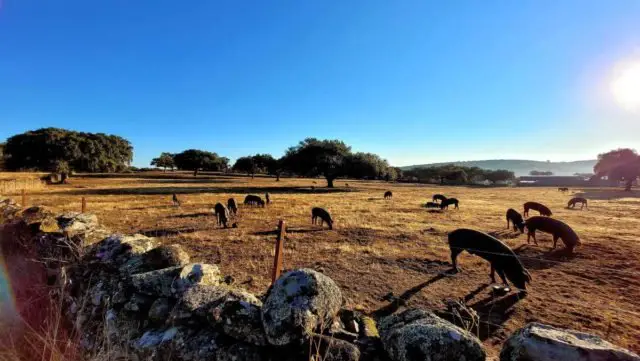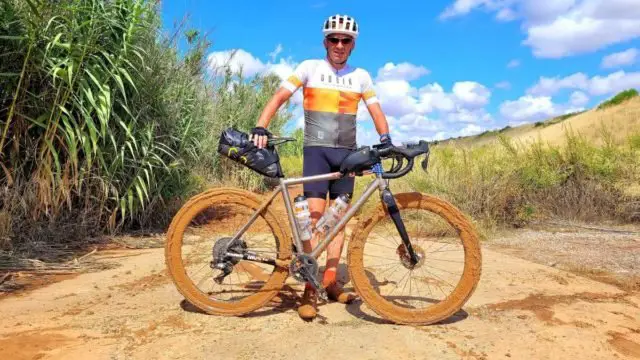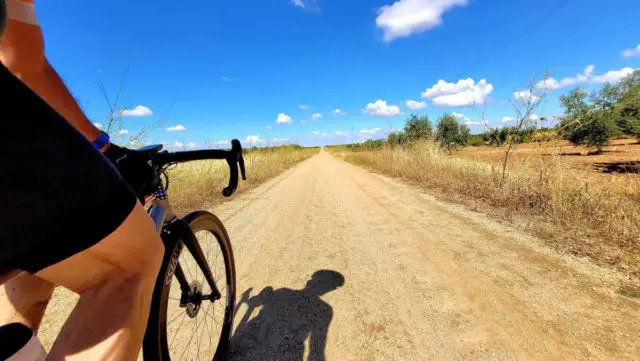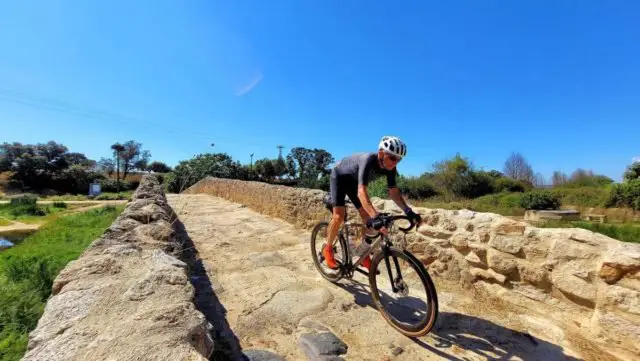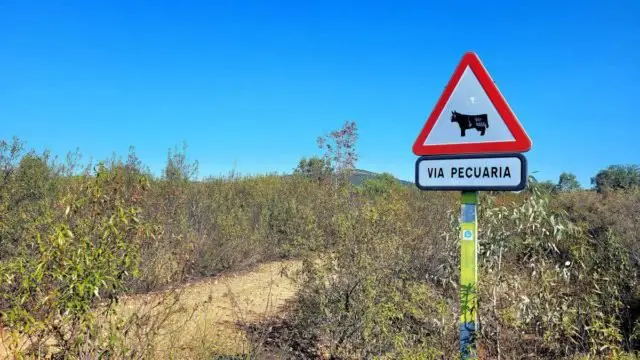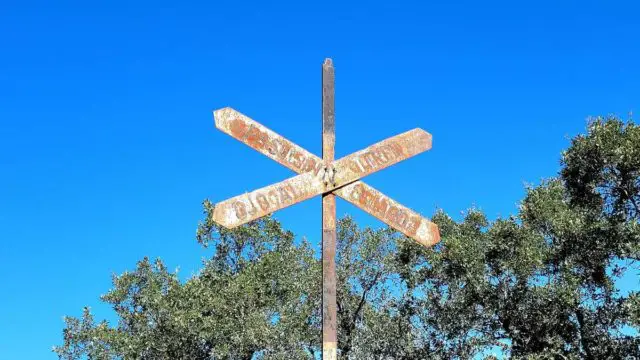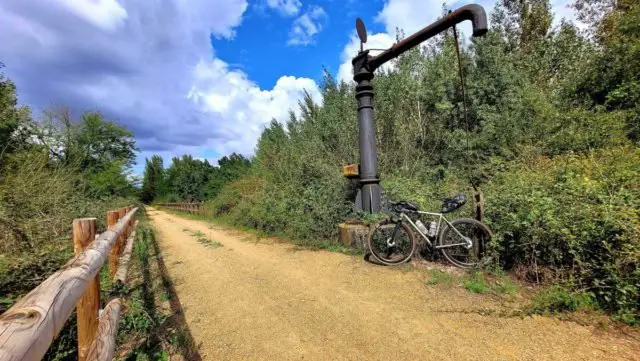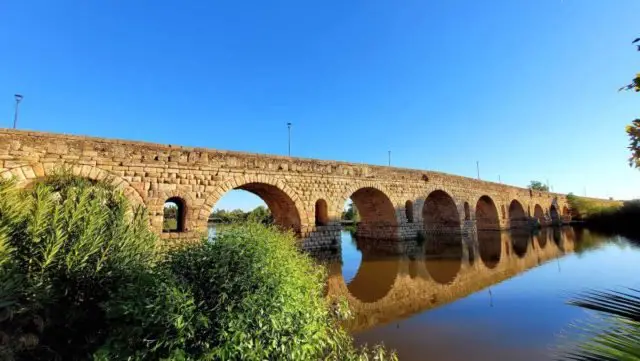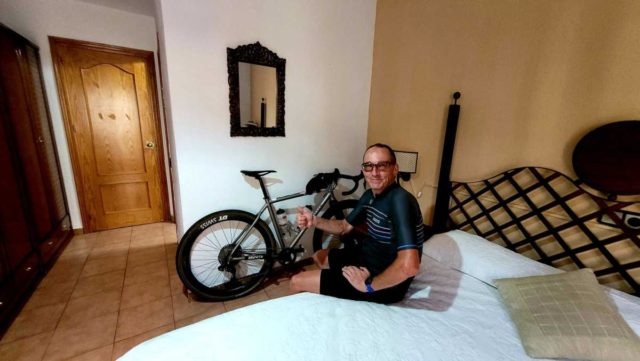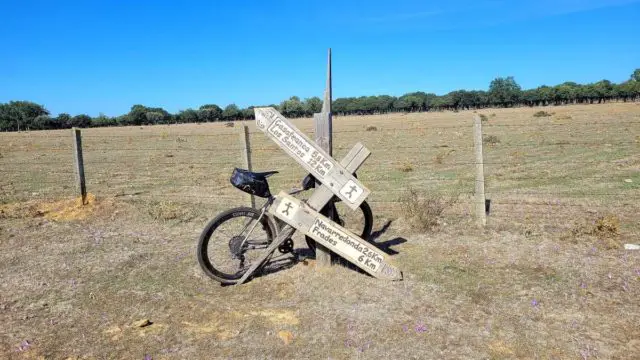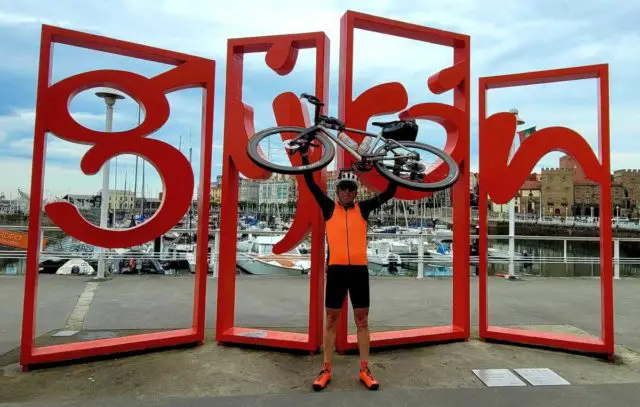The “Ruta Vía de la Plata”, also known as the Silver Route, is an old trade route of almost 1,000 kilometers from the time of the Romans. The route follows the old military roads of the Romans from Seville in Andalusia to Gijon on the Atlantic coast in Asturias. The track can also be ridden off-road away from the tourist crowds and is therefore still an insider tip for adventurous gravel cyclists today. We start appropriately at the remarkable Plaza Espana in Seville, the secret capital of Andalusia.
Light fog accompanies us for the first few kilometers. The first ascents begin after 30 kilometers, the path leads us constantly up and down hills. In El Real de Jacha we turn left in front of the Castillo onto a slope that brings us to the plateau near Monesterio.
Behind Monesterio the landscape changes, and the slopes now lead through oak forests, where black Iberian pigs cavort. We reach Zafra, a small town with a great history. The place had once become rich through long-distance trade. This can still be seen all over town today. The central square – the Plaza Mayor – has been beautifully restored and bears witness to bygone times. In the past, the alleys leading away from the square were regularly closed with wooden beams and converted into a bullring.
Before we arrive at Merida, we literally sink into the muddy slopes of the Extremadura. We have to thoroughly clean our wheels several times to rid them of the built-up mud. However. A wide and bolt-straight road, at which we ride at nearly full throttle, compensates for the earlier mud fight. Arriving in Merida, we have found no other Spanish city to equal the traces of Roman times that are as vivid as in Merida. Case in point, the area’s archaeological sites are a UNESCO World Heritage Site. There are many important examples of Roman culture in the city, and the former capital of the Roman province of Lusitania was at times one of the most important cities in the entire Roman Empire. The city’s cultural heritage makes it an attractive destination today.
Sandy tracks that demand skill and relaxation to traverse test us beyond Merida. When the ground surface changes to gravel again, we are almost in the town of Alescusar. We cross a 2,000 year-old Roman bridge and head towards Caceres. But before that, our course takes across an abandoned airfield, where the dreaded Condor Legion landed some 80 years ago.
Caceres is a city well worth seeing: As usual in Spain, the center is the Plaza Mayor with the old town hall. The lively square is surrounded by restaurants and bars. Worthy of a visit, Torre de Bujaco, built in the 12th century by the Moorish Almohads, resides today over a Roman fortress.
Moving forward, the route led through the Puerta de la Estrella to the medieval old town. A short or long stroll through the narrow streets is worthwhile. The path leads past impressive palaces, churches, and picturesque little squares.
Our track later leads through extensive pastures edged by old stone walls. A bumpy trail brings us down to a steel-blue reservoir. Before we can take a well-deserved break in Canaveral, a very special challenge awaits us. The track leads across a pasture and through the middle of a herd of black bulls. We roll through it very carefully, as if on eggshells, so as not to disturb them in any manner!
We reach Plasencia via the Puente de Trujillo, which crosses the Río Jerte. The history of the medieval city begins in 1186 with the founding of the city by Alfonso VIII. As King of Castile in 1212, the Moors and his troops suffered a decisive defeat in the battle of Las Naves de Tolosa.
Plasencia then became a bishopric (the office or rank of a bishop), which made the construction of the cathedral necessary. The cathedral was built between the 13th and 14th centuries. Construction of another cathedral began in the 15th century, but was finished in 1760. Therefore, the current cathedral of Plasencia consists of two churches – the old Romanesque Catedral Vieja and the new one, the Catedral Nueva in the Renaissance style.
The high altar and the choir in the church are particularly worth seeing. The center of the old town is the Plaza Mayor with the town hall and the beautiful arcades. The old city walls, the construction of which began as early as 1197, run around the historic center. Of the original 71 defense towers, 21 are still preserved today.
We leave the area around Plasencia via the old bumpy Roman road. We open and close countless cattle gates before a sandy trail ends on a plateau. An old monumental Roman gate heralds the ascent to the Puerto de Bejar. Via the very steep and coarse-paved Roman road, we climb almost 1,000 meters above sea level.
After a stopover in Bejar, the next morning is unusually cold. The thermometer only shows 11 degrees. With a strong headwind, we ride over deserted gravel slopes. On the way, we notice the old stone pillars from Roman times. We stay on the plateau and don’t meet a single soul all day. Only shortly before Salamanca does it get a little livelier again.
Salamanca is one of the oldest cities in the Castile and León region. “El que quiera saber que vaya a Salamanca”: If you want to gain knowledge, go to Salamanca, it is said in Spain. That was true in the past, and it is still true today. Salamanca has one of the oldest and most important universities in Europe. Many poets and thinkers received their doctoral hats here. Columbus had to convince the royal committee of scholars in Salamanca of his theory that India lies in the west – and the Dominican priest Francisco de Victoria formulated the foundations of international law here as early as 1540. A good starting point for a city tour is the famous and huge Plaza Mayor. From here we explore the pretty old university town on foot.
Heavy headwind and tough gravel crunch beneath our tires as we ride towards the northeast. The track follows an old railway line, which is decorated with faded signs from bygone times and is particularly lonely. As it flattens out, we feel like we are in the Great Plains of the USA. Wheatfields and olive trees, brown dry land, where it hardly rains.
The nearest medieval town is Zamora. The small town can look back on a long history. During the Roman time of rule, the place was an important station on the Via de la Plata between Mérida and Astorga. The Roman name Ocellum Duri, the eyes of the Duero, is still applicable today. The castle and the cathedral are in a prominent position on a hill above the river, an ideal location to control the surrounding area.
After the Moorish conquest of the Iberian Peninsula, Zamora lay in the hard-fought area between the Duero and Tagus rivers. This sparsely populated region has repeatedly become the battlefield between Christian and Islamic troops. After being destroyed by the Moors in 981, the city was only rebuilt and repopulated during the 11th century under the rule of the King of León Fernando I. Most of the historical buildings that we can visit today date from the 12th and 13th centuries.
Behind Zamora, the landscape changes its image again. It’s now on fast slopes rolling through fields. There are now many people on the track who are taking a pilgrimage to Santiago de Compostela. Before Benavente, the Ruta de la Plata runs on a “Via Verde”, an old railway line converted to a bike path. We find appropriate accommodation in the former castle, which has been converted into a hotel. At night the doors rattle and the next morning the cabinet door in the room opens as if by magic – A Poltergeist sends his regards.
Another railway bike path continues in the direction of Leon. We ride parallel to a national road on gravel to Leon. The track is identical to the pilgrim’s route that comes from Pamplona.
With 130,000 inhabitants, Leon is the capital of the province of the same name in the autonomous community of Castile – Leon. The city is packed with pilgrims from all over the world. The outstanding sights in Leon include the Gothic cathedral, the royal basilica of San Isidoro, and the former pilgrims’ hostel of San Marcos.
The next morning we cross the Asturian mountains. It is drizzling and the mountains are covered in mist. A 5-degree cold wind blows across the 1,378 meter high pass “Puerto de Pajares”.
A quick descent takes us down to Pola de Lena, where a double Cafe con Leche brings us back to life. Then follows another 5 km long ascent, which the professionals at the Vuelta have already ridden over the next mountain several times. Normally the route of the Vuelta then leads to the notorious Angliru – but our track leads us directly to Oviedo. The former city of Ovetum has been closely associated with the Asturian monarchy since it was founded in the 8th century and was even made the capital of the kingdom. In the vicinity of the cathedral, we can see some of the most important buildings in Oviedo: The Church of San Tirso, the Museum of Fine Arts, or the Museum of Archeology, which are housed in the former Velarde Palace and the San Vicente Monastery.
The last stage, our so-called “Tour d’honneur”, takes us over small, remote roads to the Cantabrian Sea. When we get lost for a moment, we suddenly find ourselves in front of the Fernando Alonso Motor Sports Museum. Along the route, we see many “Hórreos” – square wooden structures on smooth stone pillars with a tiled roof to keep food dry. You can also see some exotic villas, the “Indiano” architecture, houses built by Asturians.
The last ascent is tough, grades of 22% are frequent on the narrow roads that meander steeply up the mountain. The subsequent descent to Gijon is quite pleasant. After almost 1,000 kilometers and 10 days riding through four Spanish regions, we are at the destination of our dreams. The remoteness of Extremadura, the historical legacies of the Romans and the cities worth seeing have burned into our memories – just like our tires on the Spanish gravel slopes.
Additional Photos by Timo
Facts
The “Ruta Vía de la Plata” goes back to a historical trade route that was already used by the ancient Romans. In the off-road version, it is almost 1,000 kilometers long. It runs from Seville in the south to Gijon on the Cantabrian coast. It crosses diverse Spanish landscapes, cities, and climatic zones. Literally translated, Via de la Plata means “Silver Road”. The best time to visit is Spring and Autumn. However, expect cool temperatures from time to time and occasional rain, especially in the north. In the summer months, it is much too hot to cycle, especially in the south.
Arrival by Car:
Gijon in the north is very easy to reach. If you want to follow the route described, you can go to Seville by train or rental car (approx. 800 km). Overnight stays are not a problem along the route. From the hotel / hostel to the campsite, everything is available. It is definitely worth taking a closer look at the historic cities such as Seville, Zafra, Merida, Caceres, Plasencia, Zamora, Salamanca, Leon, and Gijon.
The Track:
https://www.komoot.de/collection/1044701/die-route-der-via-de-la-plata
Many thanks to Timo Rokitta for this contribution!



